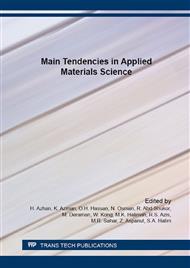[1]
A. M. Linsebigler, G. Lu and J. T. Yates Jr. Photocatalysis on TiO2 Surfaces: Principles, Mechanisms, and Selected Results. Chemical Reviews 95 (1995) 735-738.
DOI: 10.1021/cr00035a013
Google Scholar
[2]
M. R. Hoffmann, S. T. Martin, W. Choi and D.W. Bahnemann. Environmental Applications of Semiconductor Photocatalysis. Chemical Reviews 95 (1995): 69-96.
DOI: 10.1021/cr00033a004
Google Scholar
[3]
R. Asahi, T. Morikawa, T. Ohwaki, K. Aoki and Y. Taga. Visible-Light Photocatalysis in Nitrogen-Doped Titanium Oxides. Science 293 (2001): 269-271.
DOI: 10.1126/science.1061051
Google Scholar
[4]
G. Liu, L. Wang, H. G. Yang, H. -M. Cheng and G. Q. Lu. Titania-Based Photocatalysts - Crystal Growth, Doping and Heterostructuring. Journal of Materials Chemistry 20 (2010): 831-843.
DOI: 10.1039/b909930a
Google Scholar
[5]
C. M. The and A. R. Mohamed. Roles of Titanium Dioxide and Ion-Doped Titanium Dioxide on Photocatalytic Degradation of Organic Pollutants (Phenolic Compounds and Dyes) in Aqueous Solutions: a Review. Journal of Alloys and Compounds 509 (2011).
DOI: 10.1016/j.jallcom.2010.10.181
Google Scholar
[6]
J. Sykora. Photochemistry of Copper Complexes and their Environmental Aspects. Coordination Chemistry Reviews 159 (1997): 95-108.
DOI: 10.1016/s0010-8545(96)01299-4
Google Scholar
[7]
T. Morikawa, Y. Irokawa and T. Ohwaki. Enhanced Photocatalytic Activity of TiO2−xNx Loaded with Copper Ions under Visible Light Irradiation. Applied Catalysis A: General 314 (2006): 123-127.
DOI: 10.1016/j.apcata.2006.08.011
Google Scholar
[8]
D. Beydoun, H. Tse, R. Amal, G. Low and S. McEvoy. Effect of Copper(II) on the Photocatalytic Degradation of Sucrose. Journal of Molecular Catalysis A: Chemical 177 (2002): 265-272.
DOI: 10.1016/s1381-1169(01)00272-2
Google Scholar
[9]
M. Enamoto, A. Kishimura and T. Aida. Coordination Metallacycles of an Achiral Dendron Self-Assemble via Metal-Metal Interaction to Form Luminescent Superhelical Fibers. Journal of the American Chemical Society 123 (2001): 5608-5609.
DOI: 10.1021/ja010426t
Google Scholar
[10]
A. Cingolani, S. Galli, N. Masciocchi, L. Pandolfo, C. Pettinari and T. Angelo Sironi. Sorption-Desorption Behavior of Bispyrazolato-Copper(II) 1D Coordination Polymers. Journal of the American Chemical Society 127 (2005): 6144-6145.
DOI: 10.1021/ja050856+
Google Scholar
[11]
A. Kishimura, T. Yamashita, K. Yamaguchi and T. Aida. Rewritable Phosphorescent Paper by the Control of Competing Kinetic and Thermodynamic Self-Assembling Events. Nature Materials 4 (2005): 546-549.
DOI: 10.1038/nmat1401
Google Scholar
[12]
A. V. Rasika Dias, H. V. K. Diyabalanage, M. A. Rawashdeh-Omary, M. A. Franzman and M. A. Omary. Bright Phosphorescence of a Trinuclear Copper(I) Complex: Luminescence Thermochromism, Solvatochromism, and "Concentration Luminochromism. Journal of the American Chemical Society 125 (2003).
DOI: 10.1021/ja036736o
Google Scholar
[13]
A. V. Rasika Dias, H. V. K. Diyabalanage, M. G. Eldabaja, O. Elbjeirami, M. A. Rawashdeh-Omary, M. A. Franzman and M. A. Omary. Brightly Phosphorescent Trinuclear Copper(I) Complexes of Pyrazolates: Substituent Effects on the Supramolecular Structure and Photophysics. Journal of the American Chemical Society 127 (2005).
DOI: 10.1021/ja0427146
Google Scholar
[14]
R. G. Raptis and J. P. Fackler Jr. Structure of Tris(μ-3, 5-diphenylpyrazolato-N, N')tricopper(I). Structural Comparisons with the Silver(I) and Gold(I) Pyrazolate Trimers. Inorganic Chemistry 27 (1998): 4179-4182.
DOI: 10.1021/ic00296a018
Google Scholar
[15]
H. H. Murray, R. G. Raptis and J. P. Fackler Jr. Syntheses and X-ray Structures of Group 11 Pyrazole and Pyrazolate Complexes. X-ray Crystal Structures of Bis(3, 5-diphenylpyrazole)copper(II) Dibromide, Tris(μ-3, 5-diphenylpyrazolato-N, N')trisilver(I)-2-tetrahydrofuran, Tris(μ-3, 5-diphenylpyrazolato-N, N')trigold(I), and Hexakis(μ-3, 5-diphenylpyrazolato-N, N')hexagold(I). Inorganic Chemistry 27 (1998).
DOI: 10.1021/ic00274a008
Google Scholar
[16]
M. K. Ehlert, S. J. Rettig, A. Storr, R. C. Thompson and J. Trotter. Synthesis and X-ray Crystal Structure of the 3, 5-Dimethylpyrazolato Copper(I) Trimer, [Cu(pz")]3. Canadian Journal of Chemistry 68 (1990): 1444-1449.
DOI: 10.1139/v90-221
Google Scholar
[17]
K. Fujisawa, Y. Ishikawa, Y. Miyashita and K. -I. Okamoto. Crystal Structure of Pyrazolato-Bridged Copper(I) Polynuclear Complexes. Chemistry Letters 33 (2004): 66-67.
DOI: 10.1246/cl.2004.66
Google Scholar
[18]
O. M. Aly and S. D. Faust. Herbicides in Surface Waters, Studies on Fate of 2, 4-D and Ester Derivatives in Natural Surface Waters. Journal of Agricultural and Food Chemistry 12 (1964): 541-546.
DOI: 10.1021/jf60136a016
Google Scholar
[19]
R. D. Wilson, J. Geronimo and J. A. Armbruster. 2, 4-D Dissipation in Field Soils after Applications of 2, 4-D Dimethylamine Salt and 2, 4-D 2-Ethylhexyl Ester. Environmental Toxicology and Chemistry 16 (1997): 1239-1246.
DOI: 10.1002/etc.5620160620
Google Scholar
[20]
D. Kaioumova, C. Süsal and G. T. Opelz. Induction of Apoptosis in Human Lymphocytes by the Herbicide 2, 4-Dichlorophenoxyacetic Acid. Human Immunology 62 (2001): 64-74.
DOI: 10.1016/s0198-8859(00)00229-9
Google Scholar
[21]
A. A. Pochettino, B. Bongiovanni, R. O. Duffard and A. M. E. Duffard. Oxidative Stress in Ventral Prostate, Ovary, and Breast by 2, 4-Dichlorophenoxyacetic Acid in Pre- and Postnatal Exposed Rats. Environmental Toxicology 28 (2013): 1-10.
DOI: 10.1002/tox.20690
Google Scholar
[22]
J. Rivera-Utrilla, M. Sánchez-Polo, M. M. Abdel and R. Ocampo-Pérez. Role of Activated Carbon in the Photocatalytic Degradation of 2, 4-Dichlorophenoxyacetic Acid by the UV/TiO2/Activated Carbon System. Applied Catalysis B: Environmental 126 (2012).
DOI: 10.1016/j.apcatb.2012.07.015
Google Scholar
[23]
M. Trillas, J. Peral and X. Domenech. Photocatalyzed Degradation of Phenol, 2, 4-Dichlorophenol, Phenoxyacetic Acid and 2, 4-Dichlorophenoxyacetic Acid over Supported TiO2 in a Flow System. Journal of Chemical Technology and Biotechnology 67 (2011).
DOI: 10.1002/(sici)1097-4660(199611)67:3<237::aid-jctb567>3.0.co;2-4
Google Scholar
[24]
K. Djebbar and T. Sehili. Kinetics of Heterogeneous Photocatalytic Decomposition of 2, 4-Dichlorophenoxyacetic Acid over Titanium Dioxide and Zinc Oxide in Aqueous Solution. Pesticide Science 54 (1998): 269-276.
DOI: 10.1002/(sici)1096-9063(1998110)54:3<269::aid-ps811>3.0.co;2-i
Google Scholar
[25]
N. F. Ghazalli, Y. Yuliati, S. Endud, M. Shamsuddin and H. O. Lintang. Vapochromic Copper(I) Pyrazolate Complex Materials for Phosphorescent Chemosensors of Ethanol. Advanced Materials Research 970 (2014): 44-47.
DOI: 10.4028/www.scientific.net/amr.970.44
Google Scholar


